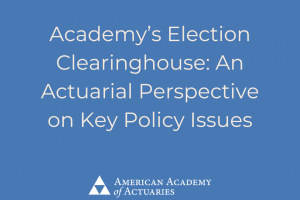By Amanda Barry-Moilanen
Policy Analyst, Life
When reasonable people come across the acronym “PBR,” it can elicit visions of mediocre beer, baseball reports, and even professional bull riding. But actuaries know better. They see “PBR” and reflect on more than a decade of transitioning from a rules-based approach to a principles-based approach for holding reserves.
For those still in the dark, PBR stands for principle-based reserving. It represents the single most significant shift in the regulatory framework for life actuaries in the 21st century. In a nutshell, PBR allows for actuarial judgment in holding reserves, rather than using regulator-prescribed formulas and assumptions.
As you may have deduced, using prescribed methods was causing some issues, namely as it related to holding reserves that were excessive or insufficient to pay claims. In the early 2000s, there was a movement to find a new way of doing things. Regulators and industry came together, assembling the best minds—including several Academy giants—and through a diligent, scrupulous process, PBR was born.
Academy volunteers have been integral in the development and implementation of PBR since the NAIC’s Principle-Based Reserving Implementation (EX) Task Force was created in 2012. Since the actuarial profession is largely self-regulated and life insurance is primarily regulated at the state level, it cannot be understated just how seismic a change this was for everyone. Shifting to a principles-based approach was a high-stakes and people-intensive venture. The Academy, in its mission to serve the public and the profession, began hosting PBR Bootcamps in 2016 to educate actuaries on this new reserving structure.
Since then, the Academy’s Life Practice Council (LPC) has hosted four in-person PBR Bootcamps across the country (including in 2024), as well as several years of virtual bootcamps. Over the past eight years, these efforts have reached thousands of actuaries and insurance professionals.
This year, Philadelphia’s Le Meridien Hotel served as the backdrop for the June 11–13 Bootcamp. Academy staff and members of the LPC’s PBR Implementation Subcommittee assembled an impressive cast of facilitators, including regulators, consultants, auditors, life insurance experts, annuity experts, and reinsurers.
Bootcamp topics ranged from hedging to mortality, reporting to governance, modeling to assumptions, and anything else one may need to know to apply PBR to their everyday work.
Donna Megregian, longtime Academy volunteer, a 2024 PBR Bootcamp facilitator, and chairperson of the Life Products Committee, said, “The Bootcamp gives you a lot of insight and best practices from people who have been working in it and refining it since its inception. PBR is still developing and changing, so Bootcamp gives you a head start in approaching the challenges of implementing and maintaining PBR.”
Although we were briefly interrupted by a rogue fire alarm, participants in this year’s Bootcamp were completely immersed in the world of PBR for three lively and informative days. They were able to interact with industry experts, have their questions answered by regulators, and meet like-minded folks.
In an effort to provide actuaries with as many resources as possible on PBR, the Academy has published practice notes, issue briefs, and ASOPs. In fact, there is a PBR Toolkit on the Academy’s website available to the public—an invaluable resource for our members and the regulatory community.





